Your DAC came with a basic setup guide and manual, but we regularly hear from owners with uncertainty. So we decided to sit down and play “Will it connect?” with some of our gear and share practical examples.
For help connecting a DAC to your phone or tablet, please see How to Connect Android, iPad, or iPhone to a DAC.
Powered Speakers
Everyone loves the convenience of powered speakers, and JDS Labs customers often want to make full use of their DACs with their headphone and speaker systems. Below are the most common connections.
Unbalanced Inputs: RCA or 3.5mm
RCA cables are definitely the easiest way to connect most DACs to a set of powered speakers. Simply run an RCA cable from your DAC’s RCA outputs to the RCA inputs of your speakers. Make sure everything is powered on and you’re good to go!
If your DAC and speakers use 3.5mm jacks, simply use an auxiliary cord.
To connect a 3.5mm jack to RCA jacks, use a 3.5mm to RCA adapter cable. While measurable crosstalk performance is best via RCA cabling, there is no audible penalty by using an adapter.
Both?
The Audioengine A2+ speakers pictured above provide several inputs, including 3.5mm, RCA, and even their own integrated USB DAC. It’s generally best to use RCA cables to connect a DAC. Please refer to your speakers’ manual for more help.
Listening to Headphones or Speakers
If your desktop audio system includes a JDS Labs Element or EL Amp, you can transition between your powered speakers and headphones. Plug in your speakers via RCA and headphones via front-mounted ¼” jack, then press the power button to toggle between your speakers and cans. Edit: Preamp output is also available in our newer Atom Amp, EL Amp II, and Element II.
For headphone amps and DACs without preamp RCA outputs, you can manually unplug your DAC and reconnect to speakers as needed, or use an OL Switcher to transition between setups with a switch.
Balanced Inputs
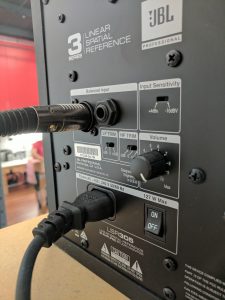
Balanced speaker inputs, either XLR or TRS, can be connected to an unbalanced (single-ended) DAC.
XLR Inputs
To connect a DAC with RCA outputs to a balanced XLR input, such as JBL LSR305‘s, simply use two XLR to RCA cables (one cable per speaker). That’s it!
TRS Inputs
TRS jacks, also referred to as ¼” inputs, are trickier. In a balanced system, the pinout may or may not be known. The positive (non-inverting) and negative (non-inverting) balanced signals may be opposite in some systems, so only make use of TRS inputs if you can determine the exact pinout. Once you have determined your speaker input pinout, use a ¼” TRS to RCA splitter paired with RCA cables to access only the positive portion of the balanced signal.
Here’s the trick: Ignore the colors at the TRS splitter! You must connect the positive signal of your Left speaker to the Left RCA jack of your DAC, and connect the positive signal of your Right speaker to the Right RCA jack of your DAC. This means you’ll have either two reds, or two whites connecting to the DAC. Ignore the inverting signal. In other words, you will be left with one unused connector at the splitter of each speaker. It’s messy. For this reason, we recommend using XLR to RCA cables if at all possible.
Optical Sources
Xbox One
Connect your DAC to the Xbox One using the Optical jack on the rear. Make sure all is turned on and you’re looking at your Xbox One dashboard. Follow this selection path through the Settings Menu:
Audio and Video → Audio Options
Make sure you’ve selected Optical Output and Uncompressed Stereo and enjoy!
PS4
Connect your DAC to the PS4 using the Optical jack on the rear. Make sure all is turned on and you’re looking at your PS4 dashboard, then follow this selection path through the Settings Menu:
Sound and Screen → Audio Output Settings → Primary Output Port
Make sure you’ve selected Digital Out (Optical) and set the audio format to Linear PCM.
The PS4 is a little finicky and will also output audio via HDMI even after all of these steps. After scouring the internet and troubleshooting in the office, the best solution for this is muting the device outputting audio via HDMI.
PS4 is also known to limit output volume. If you plan to listen to your DAC with a PS4, please tell us when placing your order. We can force your DAC’s firmware to require PS4 to set 100% output volume.
Feel free to reply below or email us with any questions!

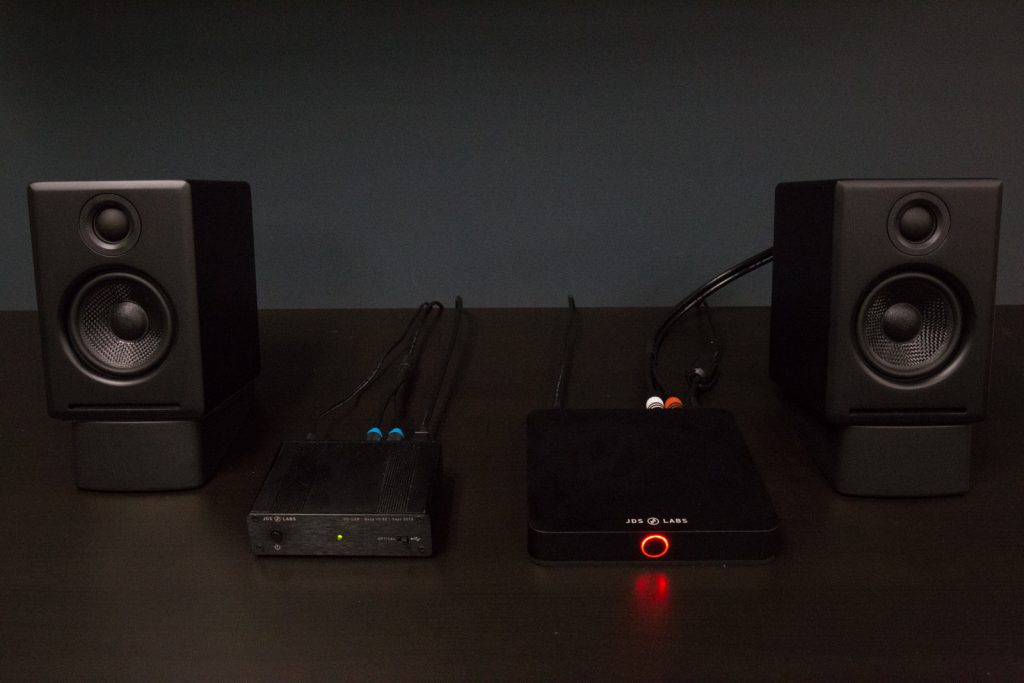
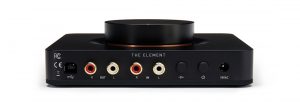
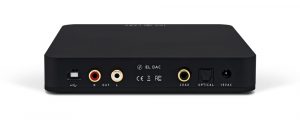
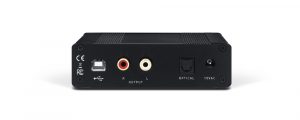
Thank you very much for this information it was extremely helpful!!
When using the Element with powered speakers, is the head amp gain circuit applied to the RCA outs ? (if ordered with that option)
No, the rear outputs are true DAC line outputs (no amplifier gain or buffer)
Thanks for your answer John. So, volume control is not inline with the rear outputs also?
Can I use both the el DAC and el amp together with Xbox one?
@Justin: Yes, that’s correct.
I bought two xlr male to rca male cable and used them to connect my jbl lsr 305p to my dac, the dac is connect to my tv with toslink. I am not getting any sound, what did I do wrong? are the cables i used have the wrong pin configuration?
Are you sure the DAC is generating audio? Sounds like the TV is not delivering a valid signal.
the dac is working with my ps4 : PS4 > optical out to dac > dac rca out with a rca to 3.5mm converter > bose campanion 20 connects to the 3.5mm
But it’s not working with my tv with the xlr to rca cable. So i am assusiming simething wrong with my cable or speaker. It’s hard to trouble shoot.I bought this trs to dual rca cable https://www.amazon.com/Hosa-CPR-203-Stereo-Interconnect-Meters/dp/B000068O18. also bought a dual trs to 3.5 mm to see if it work directly on my desktop pc. Haven’t rececive those yet.
@JOHN SEABER turns out there is some issue with my dac, after changing my dac to smsl m100, the xlr to rca cable works fine
Hi Guys!
So which product AMP DAC wise is the way to go from JDS? I would like to also use it to power my AKG712s, HD660s and My Hifiman HE 4xx’s to its potential and also use it through my console (PS4). I have a modmic setup on all my Headphones.
When you recommend a model, could you also let me know if it supports Dolby Digital processing….
Thanks for the help!
@Sergio – Sorry, we do not support Dolby formats.
A JDS Labs OL DAC or EL DAC II will be best, since these will allow you to connect your PS4 via optical.
I wonder if I am the only person in the world looking to connect a ”self powered speaker dock’ to a ‘DACS’ device ??
Cannot find any information on what the best set up is for just 1 speaker (not a hifi stereo unit!).
Maybe it is 2 x RCA (rear of DACS) into 3.5mm pin (rear of SPEAKER DOCK). Or maybe this will not work as it is steareo into mono!!??
Any chance you can post/reply with information on setting up speaker docks (not stereo speakers) with DACS units………….Many thanks……….Sam
Hi Sam – This question is rather broad. What exact dock are you referring to? There is no common standard for docks, and by nature, a dock is intended for docking with a specific device. You will be reliant on the output capabilities of your specific dock.
In simplest terms, a DAC accepts digital input and delivers analog audio. Most common digital inputs are USB or optical.
Very new to using audio equipment that isn’t a sound card in a computer. Just bought the Atom Amp+ and Atom DAC+ and the amp is connected to my powered speakers via RCA.
How should I set the volume on the speakers themselves? Should the speakers be turned all the way up and control volume only by the amp or is there some sweet spot between the speaker volume and the amp volume?
@Gideon – In general, it’s best to control volume using the last volume control in the signal chain. Set all volume controls earlier in the chain to 100%. In other words, use the volume knob of your speakers and leave the amp and DAC at max.
I have the JDS Atom Amp+ and Dac+ that I would like to hook up to my Logitech G560 PC speakers/subwoofer. The Logitech speakers do not have RCA jacks but it does have a 3.5mm aux port. If I get a RCA to 3.5mm adapter, will that work or should I just try using this method with the amp and not use the dac. I am not sure if they are compatible or not. Any help would be appreciated. Thank you.
Yes, simply use a 3.5mm to RCA adapter, such as: https://jdslabs.com/product/rca-35mm-female-adapter-6in/